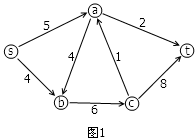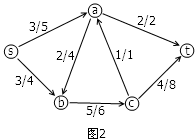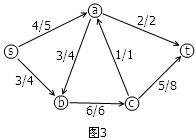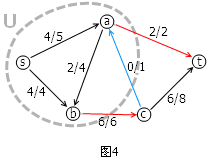曾經,沒有筆記本電腦時,我從來不用它浪費時間。曾經沒有手機的時候,我從來不用它玩遊戲。科技帶給了我們的便利,卻也讓我玩物喪志。我現在有非常嚴重的拖拉症,只是我不知道怎麼來處理這件事。我的青春也好,時間也好,生命也好,難道都要被這只野獸吃掉了嗎?難道理想也好,夢也好,野心也好都要被這怪物給吞噬了嗎?
我的人生不應該如此,我不知如何是好。我沒有進入到任何一個領域去,我說我沒有興趣,原因其實是我沒有進入。我是個傻叉,我在浪費我的智商,在浪費我的生命。比如天天在這裡耗著,還不如去工作賺錢好了…
我的激情去哪裡了?我的野心去哪裡了?
Tuesday, March 19, 2013
Wednesday, March 13, 2013
Useful Links
My WebPage: http://pha.jhu.edu/~lyang
Arxiv of Cosmology: http://arxiv.org/list/astro-ph.CO/recent
Arxiv of Complexity Theory: http://arxiv.org/list/cs.CC/recent
Arxiv of Cosmology: http://arxiv.org/list/astro-ph.CO/recent
Arxiv of Complexity Theory: http://arxiv.org/list/cs.CC/recent
Ford–Fulkerson Algorithm
Matrix67 today mentions a Ford–Fulkerson Algorithm, very interesting. If you cannot read Chinese, I translate a part of the Algorithm here.
As shown in the Fig-1, there's a directed graph, which is used representing the network of the traffic. The number on each arrow is the maximum allowed current at a certain time. If cars are driving in this network, one condition (current conservation) must always be satisfied: the total income should equal to total output at any node except for s and t. Now the problem is what's the maximum flow current from node s to node t? A attempting solution might be like following:
where the numerator is the attempting current and the denominator is the maximum allowed current of the arrow. Such a flow distribution will yield a total current of 6. However it's definitely not the maximum current of the network. For example, if we add another path s->a->b->c->t for current 1, we'll get current 7.
On Fig-3, we could add another "path" s → b → a → c → t , in which b->a and a->c are along the opposite direction of the original paths. So they have negative current. Applying this path, we'll have
Fig-1
Fig-2
Fig-3
Mathematician Lester Ford, Jr. and Delbert Fulkerson gives a solution to this problem, the so called "Ford–Fulkerson Algorithm":On Fig-3, we could add another "path" s → b → a → c → t , in which b->a and a->c are along the opposite direction of the original paths. So they have negative current. Applying this path, we'll have
Fig-4
We successfully increase the total current by 1 and still satisfied current conservation. Such a path is called "extensive path". As long we could find additional extensive path from s to t, the maximum current is not reached. While we can prove that if no additional extensive path can add, we have the maximum total current. Fig-4 shows the maximum current solution of the above problem.
There are a lot of applications of this algorithm in Operation Research.
Subscribe to:
Posts (Atom)



